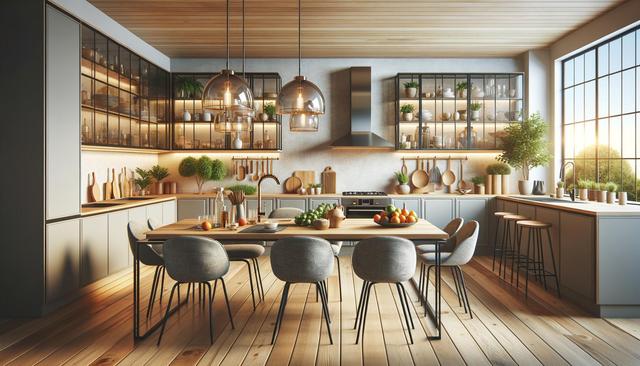Smart Technology Integration
Kitchen remodeling in 2025 is all about seamless technology integration. From smart faucets that conserve water to refrigerators that track expiration dates, modern homeowners are embracing innovations that enhance daily routines. Voice-controlled appliances and app-connected cooking devices help streamline meal preparation and reduce clutter. These tools not only offer convenience, but they also contribute to energy efficiency and sustainability—two major design goals for the modern home.
Some of the most popular smart kitchen additions include:
- Touchless faucets with motion sensors
- Wi-Fi enabled ovens and cooktops
- Smart lighting systems that adjust based on time of day
- Refrigerators with food inventory apps
When planning a remodel, it’s wise to consider how these technologies will fit into your layout. Strategically placing outlets, charging ports, and device hubs ensures your kitchen remains functional and future-ready.
Minimalist Design with Functional Storage
The clean, uncluttered look continues to dominate kitchen design in 2025. Minimalism doesn’t mean sacrificing function—it means optimizing space with purpose. Cabinets are sleeker, often handle-free, and designed to seamlessly blend into the background. Open shelving is used sparingly to showcase key pieces without overwhelming the space.
Storage is smarter and more efficient, with interior organization systems that make the most of every inch. Popular storage solutions include:
- Pull-out pantry systems
- Corner drawers and lazy Susans for deep cabinets
- Drawer dividers for utensils and spices
- Hidden compartments for small appliances
By focusing on simplicity and utility, homeowners are creating kitchens that feel open, calm, and easy to navigate—even in smaller spaces.
Bold Color Accents and Contrasts
Color is making a strong comeback in 2025 kitchen remodels. While neutral tones like white, gray, and beige still serve as a base, bold accent colors are being used to add personality and flair. Deep navy, forest green, and matte black are especially popular for cabinets and islands, creating a striking contrast with lighter wood tones and countertops.
Designers are also experimenting with colorful backsplashes and tiled walls. These elements add visual interest without overwhelming the space. If you’re hesitant to commit to bold cabinetry, consider adding color through:
- Bar stools or dining chairs
- Decorative light fixtures
- Rugs and runners
- Open shelf displays with colorful dinnerware
Using color strategically can transform a kitchen from ordinary to distinctive while staying aligned with your personal style.
Sustainable Materials and Eco-Friendly Choices
Sustainability is more than a trend—it’s a guiding principle in modern kitchen design. In 2025, homeowners are placing greater emphasis on environmentally responsible materials and energy-efficient appliances. From reclaimed wood cabinetry to countertops made from recycled glass, the focus is on reducing environmental impact without compromising style.
Eco-friendly remodeling choices include:
- LED lighting and energy-efficient appliances
- Low-VOC paints and finishes
- Water-saving fixtures
- Bamboo or cork flooring
These choices not only promote a healthier home environment but also contribute to long-term savings. As sustainability becomes a cornerstone of design, expect to see more manufacturers offering eco-conscious product lines for every budget.
Multifunctional Layouts for Everyday Living
Today’s kitchens are not just for cooking—they’re spaces for gathering, working, and relaxing. In 2025, multifunctional layouts are essential, especially in open-concept homes. Islands are larger and more versatile, doubling as prep stations, dining areas, and remote workspaces. Built-in seating, such as banquettes or window benches, adds comfort and utility.
To create a space that adapts to your lifestyle, consider:
- Installing under-counter storage for laptops and chargers
- Using movable carts for flexible prep or serving space
- Including charging stations and outlets in island designs
- Designating zones for different tasks (e.g., cooking, dining, working)
Flexible design is key to future-proofing your kitchen. Whether you’re hosting a dinner party or helping kids with homework, the right layout can make transitions seamless and enjoyable.
Conclusion: Designing Kitchens for the Future
Modern kitchen remodeling in 2025 is driven by a blend of style, technology, and sustainability. Whether you’re drawn to smart appliances, bold colors, or eco-friendly materials, the goal is to create a space that feels both functional and inspiring. By focusing on minimalist design, practical layouts, and thoughtful features, you can transform your kitchen into a central hub that meets the evolving needs of your household. Embrace the trends that make sense for your space and enjoy a kitchen that’s ready for the future.


